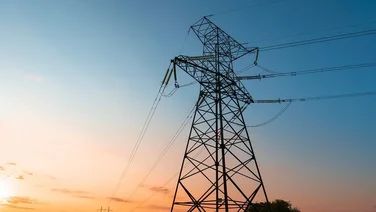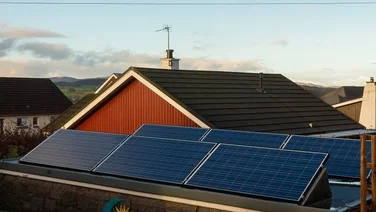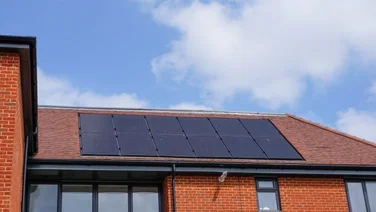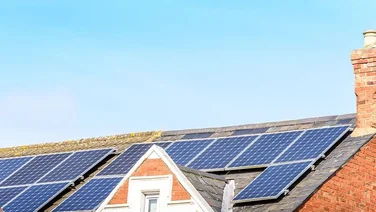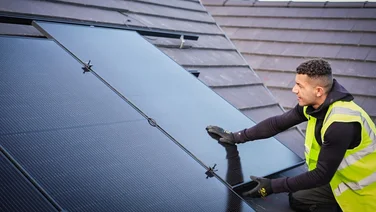- The average pergola can fit three to five solar panels
- Adding solar panels to a pergola typically costs between £2,108 and £3,513
- Solar panel pergolas can save you up to £270 a year on electricity bills

How well do solar pergolas work and how do they differ from other types of solar panels?
We’ll answer these questions in this article. We’ll also explain what exactly solar panel pergolas are, how they work, and how they’re installed.
If you want to skip ahead and speak to a solar panel installer, we can help. Just fill in our short form, and we’ll pass your contact information on to our network of installers, who’ll be in touch with quotes.
Where do you want to install solar panels?
Get startedWhat is a solar panel pergola?
A solar panel pergola is a garden structure built from posts and beams that features a roof with solar panels. The solar panels can either be used as a roof for the pergola or can be placed on top of the pergola’s existing roof.
It can either be freestanding or partially attached to the house, which is known as a lean-to pergola.
Solar panel pergolas can be made from scratch. Alternatively, solar panels can be added to an existing pergola, as long as the structure is strong enough to hold their weight.
Do solar panels on pergolas work well?
Solar panels on pergolas can work well, however it depends on the angle and direction of the solar panels.
In the UK, solar panels should ideally be south-facing and tilted at an angle between 20° and 50°. This exposes them to the optimal amount of sunlight throughout the day, which allows them to produce more electricity.
The angle of the roof can be an issue with pergolas. A lot of pergolas have a flat roof, or a slightly tilted roof, which means the roof angle is either 180° (a flat angle), or 20° (a slight tilt) at most.
If this is the case with your existing pergola, the solar panels can be put on mounts to get them to the optimal angle.
If you’re installing a new pergola, make sure the roof is constructed at the right angle so your solar panels have the best sunlight exposure.
It’s important not to lay solar panels on a flat surface, as this exposes them to less sunlight and increases the risk of dirt or debris building up on them, which reduces efficiency.
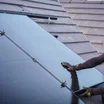
Get free solar panel quotes
Answer a few quick questions, and our trusted installers will send you bespoke solar panel quotes – for free.
The pros and cons of solar panel pergolas
- They make a great alternative option for those with unsuitable roofs
- They’re an efficient use of garden space
- They can be more aesthetically pleasing than solar panels on a roof, as they integrate seamlessly into outdoor spaces
- They can be used as a supplement if you already have solar panels on the roof of the home
- Solar panel pergolas are more expensive than regular pergolas
- The existing pergola might not be very large, or not have the optimal angle or direction for solar panels
- Pergolas might be more at risk of shading from nearby trees or buildings
Where do you want to install solar panels?
Get started
How to build a solar panel pergola in six steps
Opting for the DIY route? If you want to save costs, it’s definitely possible to build a solar panel pergola by yourself – but you need to know what you’re doing first.
Here’s how to bring your solar panel pergola to life in six simple steps:
- Plan your project Before you get hands-on, you need to define the goals of your project, including how much energy you want the pergola to produce, how big it’s going to be and how it’s going to look. You’ll have to create detailed structural plans for your pergola, carefully outlining its dimensions, the materials used, the type of solar panels, the layout of the solar panels and the angle at which they’ll be placed.
- Source your tools and materials You’ll need a variety of carpentry and electrical materials to build your solar panel pergola, including lumber, fasteners, metal brackets and a concrete mix for the structure, and solar panels and inverters to turn the sunlight into energy.
- Construct the pergola frame Now it’s time to build the frame of the pergola based on your designs. If you aren’t an experienced carpenter or construction worker, we recommend calling in support from a pergola specialist.
- Install the solar panels Solar panel installation for pergolas is similar to rooftop panel installation. First, you’ll need to inspect the structure to make sure it’s stable enough to hold solar panels. Then you’ll need to attach anchors and a mounting system to the roof of the pergola, on to which they’ll securely fix the solar panels.
- Connect your home’s electricity system The next step is to connect the solar panels to the home’s electrical system so the panels can feed the electricity they generate into your home. Depending on how far away the pergola is from the house, your installers might have to excavate some ground on the property to bury the connecting cables.
- Install the inverter The wires running from the solar panels to the house need to run through a solar inverter, which converts the direct current (DC) that electricity panels generate to the alternating current (AC) electricity that your home uses. This inverter will usually be installed near your home’s electrical consumer unit, as they need to be connected to each other.
While these are the main steps involved in building a solar panel pergola, the construction process will vary depending on the type of pergola. Once it’s constructed, you’ll also have to test the system and regularly check for signs of wear and tear or weather damage.

Get free solar panel quotes
Answer a few quick questions, and our trusted installers will send you bespoke solar panel quotes – for free.
How much do solar panel pergolas cost?
Solar panel pergolas cost between £2,108 and £11,510, depending on if you already have a pergola. The overall cost will also hinge on a variety of factors, such as the pergola’s size, the materials used and its design.
For reference, a new pergola costs between £3,000 and £8,000 to buy and construct. You’ll then need to add the cost of solar panels on top of this, which costs an average of £702 each, depending on what type you choose.
Based on these average costs, this is how much you can expect a solar panel pergola to cost you:
- A pergola with three solar panels will cost around £5,107 to £10,107
- A pergola with four solar panels will cost around £5,808 to £10,808
A pergola with five solar panels will cost around £6,510 to £11,510
Find out more about solar panel costs by visiting our page that has a full breakdown.
Are there any grants for solar panel pergolas?
There are no grants for solar panel pergolas specifically, however, there are several general grants for solar panels.
These include the ECO4 Scheme and the new Warm Homes Local Grant (which has largely replaced the Home Upgrade Grant, which closed in March 2025), both of which are available to low-income households or those on certain benefits.
These grants won’t pay for the construction of a new pergola but if you have an existing pergola, and you meet the eligibility criteria, the grants might be able to fund the installation of solar panels.
Learn more about how to get government grants for solar panels.
How much money will solar panel pergolas save you?
A solar panel pergola could save you between £160 and £270 a year on your electricity bills, assuming the pergola can fit between three to five solar panels.
How much you save will depend on a number of factors, including the size of your solar panel system, how much direct sunlight it receives and whether you receive payments from a Smart Export Guarantee (SEG) tariff.
The more solar panels you can fit on the pergola, the more money you’ll save.
However, if the solar panels regularly fall under shade from trees or buildings, this could affect how much electricity they generate, lowering your savings.
Is your property suitable for a solar panel pergola?
To determine whether your property is suitable, you need to ask yourself a few questions:.
- Can you install solar panels on your roof? The reason most residential solar panels are installed on the roof is that it’s an unused area of the house with a lot of free space, and they are less likely to fall under shade from other houses. This would be the optimal solution for most homeowners, but if you can’t or don’t want to use your roof space, a solar panel pergola might be the right option.
- Is your pergola strong enough to hold solar panels? You need to make sure that your existing pergola, or the pergola you plan to build, is suitable for solar panels. If your structure is strong enough to hold the weight of the solar panels, this could be a good course of action.
- Is your pergola unobstructed from shade? Additionally, the top of the pergola should not be shaded by nearby trees or buildings. If this is not possible, your solar panel pergola won’t be capable of converting much sunlight into energy.
- Can the solar panels be installed at the correct angle? Finally, the solar panels should ideally be installed facing south and at a 20° to 50° angle, as this is how they will capture the most sunlight. If your existing or new structure can facilitate this, it will maximise the efficiency of your solar panel pergola.
The solar panels should ideally be installed facing south and between a 20° to 50° angle, as this is how they will capture the most sunlight. If your existing or new structure can facilitate this, it will maximise the efficiency of your solar panel pergola.
Next steps
Whether you build one from scratch or install panels onto an existing structure, solar panel pergolas can be a great alternative, or addition, to traditional roof-mounted systems.
They’re an efficient use of garden space, and they lower your electricity bills and carbon footprint.
If you’re ready to get solar panels installed, just fill in our quotes form. We’ll pass your details on to trusted solar panel installers, who’ll be in touch to offer you their best prices.


